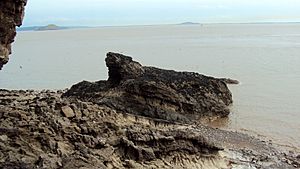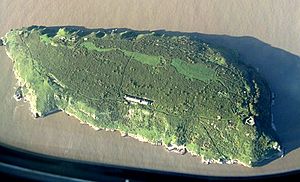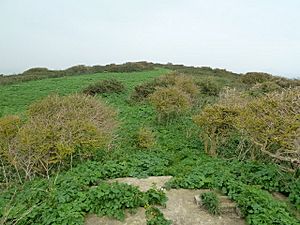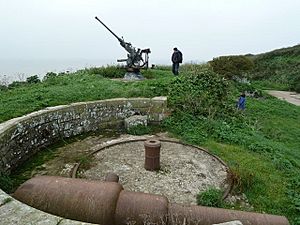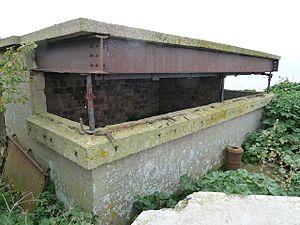Steep Holm facts for kids
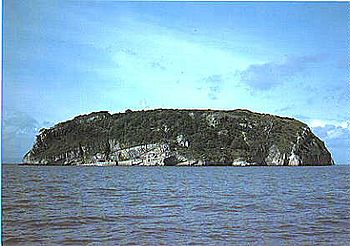 |
|
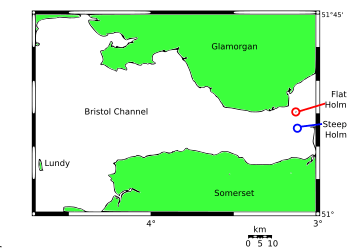 |
|
| Geography | |
|---|---|
| Location | Bristol Channel |
| Coordinates | 51°20′23″N 3°06′35″W / 51.33972°N 3.10972°W |
| Length | 1 km (0.6 mi) |
| Width | 400 m (1,300 ft) |
| Highest point | 78 m (256 ft) |
| Administration | |
|
England
|
|
| Unitary Authority | North Somerset |
| Ceremonial County | Somerset |
| Civil Parish | Weston-super-Mare |
Steep Holm is a small English island located in the Bristol Channel. It covers about 49 acres (20 hectares) at high tide. When the tide is low, it grows to about 63 acres (25 hectares). The island's highest point is 78 meters (256 feet) above the sea.
Today, Steep Holm is mostly empty, except for its wardens. It is a special nature reserve and a Site of Special Scientific Interest (SSSI). This means it is protected for its wildlife and plants. The island is home to many birds and unique plants like wild peonies.
People have lived on Steep Holm for a very long time. There might have been people here as early as the Iron Age. The Romans used it as a signal station. Later, in the 6th century, a saint named Gildas lived there. A small church (priory) was also on the island in the 12th and 13th centuries.
In the 1860s, Steep Holm became a fort to protect the Bristol Channel. It had big guns and was part of the Palmerston Forts. These forts were used again in World War I and II. Today, the island is owned by the Kenneth Allsop Memorial Trust. They work to protect its nature and history.
Contents
Exploring Steep Holm's Nature
Steep Holm is made of a type of rock called Carboniferous Limestone. It is like a natural barrier against wind and waves. This helps protect the upper parts of the Bristol Channel.
The island rises about 60 meters (200 feet) from the sea. The sea around Steep Holm has very big tides. The water level can change by as much as 13 meters (43 feet). This is one of the biggest tidal changes in the world.
There are many caves on the island's cliffs. Some are near the water, and others are high up. These high caves were once at the waterline thousands of years ago.
Steep Holm's Plants and Animals
Steep Holm is a protected nature reserve. It is also a Site of Special Scientific Interest (SSSI). This protection helps keep its special wildlife safe.
The island has many birds, especially European herring gulls and lesser black-backed gulls. There have also been a few small deer called muntjac deer.
The soil on the island's top is thin, only about 15 to 30 centimeters (6 to 12 inches) deep. It is reddish because of iron in the rocks.
Steep Holm is the only place in the UK where wild peonies grow naturally. These beautiful flowers may have been brought to the island by monks or Romans long ago. Other common plants include Alexanders, golden samphire, and wild leeks. The only reptiles found on the island are slowworms.
A Look into Steep Holm's Past
People have lived on Steep Holm for thousands of years. The oldest signs of humans are bones found in a cave. Tools made of flint from the Stone Age have also been found.
Ancient Times: Romans and Early Settlers
The Romans built something on the island, possibly a signal station or watchtower. They left behind pottery, coins, and even parts of a heating system. This suggests they had important buildings there. A carved stone head found on the island might be from the Iron Age or Roman times.
Religious Life on the Island
Legend says that Gildas, a famous writer from the 6th century, lived on Steep Holm. He was a hermit, meaning he lived alone for religious reasons. Another saint, Dubricius, is also said to have retired to the island.
In the 12th century, a small church (priory) was built on Steep Holm. Monks lived there for about 50 years. They left between 1260 and 1265 because they didn't have enough money to keep the priory going.
Island Owners and an Old Inn
Over the centuries, Steep Holm was owned by different powerful families. In the 14th and 15th centuries, people called "warreners" lived there. They raised rabbits for food.
In 1832, a man named Colonel Tynte leased the island. He opened an inn for sailors. The Harris family ran the inn, selling rum and tobacco. They even tried to say the island was outside the law, but a court case in 1884 proved them wrong.
Later, another person ran the inn, offering fishing and boating holidays. A new pier was built to make it easier to land on the island. A clergyman named John Ashley also visited the island to help sailors. His work led to the creation of the Mission to Seafarers, which still helps sailors worldwide today.
Steep Holm as a Fort
In the 1860s, Steep Holm became a military fort. It was part of a line of forts built to protect the Bristol Channel from invaders. These forts were called Palmerston Forts.
Construction started in 1865. Workers built roads, barracks (places for soldiers to live), and gun emplacements. These were concrete areas where large guns were placed. Some of these old buildings are now protected as historic sites.
The fort had ten large guns. However, by 1898, these fixed guns were no longer effective against modern warships. The fort was then closed down.
Steep Holm in the World Wars
The old fort facilities were used again during World War I and World War II. From 1915 to 1919, the island was a coastguard station.
In World War II, searchlight batteries were added. Soldiers from the Indian Army Service Corps helped fortify the island. They used mules to carry heavy guns and equipment up the steep cliffs. Later, they built a special railway with a winch to move supplies. The island also had large guns and machine guns to defend against air attacks.
After the wars, parts of the underwater telegraph cable connecting Steep Holm to another fort were stolen.
Steep Holm Today

In 1953, a group called the Steep Holm Trust leased the island. They worked to repair buildings and study the birds.
In 1974, the Kenneth Allsop Memorial Trust took over the lease. This charity bought the island in 1976. Their goal is to protect the island's nature, history, and beauty. They also want to teach people about its natural science.
You can visit Steep Holm today! The trust offers day trips by boat from Weston-super-Mare. One of the old barracks buildings is now used for visitors. The island has even been featured in a Bollywood film and a crime thriller book.


